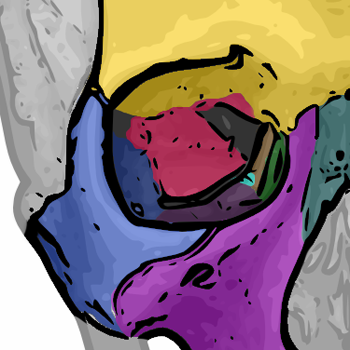Orbital Tumors - Bone Anatomy
Orbital Anatomy
The orbits are conical or four-sided pyramidal cavities, which open into the midline of the face and point back into the head. Each consists of a base, an apex and four walls. They protect the eye from mechanical injury
The base, which opens in the face, has four borders. The following bones take part in their formation:
- Superior margin: frontal bone
- Inferior margin: maxilla and zygomatic
- Medial margin: frontal, lacrimal and maxilla
- Lateral margin: zygomatic and frontal
Orbital volume and dimensions: = 30 cc, 35(Height) x 45(Width) x 45 mm(medial wall depth), globe 25 x 25 mm
Bones: (F)rontal, (M)axillary,(Z)ygomatic, (L)acrimal, (E)thmoid, (P)alatine, (S)phenoid
- Fissures
- Superior orbital fissure (SOF):
- 22 mm long
- separates greater wing of sphenoid from lesser wing of sphenoid
- transmits third, fourth, sixth and V1 AND SYMPATHETIC FIBERS
- lateral rectus origin separates into superior and inferior divisions
- Superior division transmits lacrimal, frontal and trochlear nerves
- Inferior division transmits superior and inferior divisions of CN III, nasociliary branch of CN V, CN IV, superior ophthalmic vein, and sympathetic nerve plexus
- Venous system: superior ophthalmic vein
- Inferior orbital fissure (IOF)
- Located between lateral orbital wall and the orbital floor
- Transmits V2 ( maxillary) , pterygoid nerves nerve arising from pterygopalatine ganglion
- infraorbital nerve (a branch of V2) enters the infraobital groove and infraorbital canal for sensation to lower eyelid, cheek, upper lid, upper teeth
- Venous system inferior ophthalmic vein
Holes/Notches/Canals
Nasolacrimal canal Nasolacrimal canal
- lacrimal sac fossa to the inferior meatus
- separates greater wing of sphenoid from lesser wing of sphenoid
- transmits third, fourth, sixth and V1 AND SYMPATHETIC FIBERS
- lateral rectus origin separates into superior and inferior divisions
- Superior division transmits lacrimal, frontal and trochlear nerves
- Inferior division transmits superior and inferior divisions of CN III, nasociliary branch of CN V, CN IV, superior ophthalmic vein, and sympathetic nerve plexus
- Venous system: superior ophthalmic vein
- Supraorbital foramen/notch
- transmits blood vessels
- supraorbital nerve
- Anterior/posterior ethmoidal foramen: transmits ethmoidal blood vessels and nerve
- Zygomatic foramen: transmits zygomaticofrontal and zygomaticotemporal nerves, zygomatic artery
- Nasolacrimal duct (NLD): exits into inferior meatus
- Infraorbital canal: transmits infraorbital nerve (V2)
- Ethmoidal foramina
- anterior ethmoidal artery
- posterior ethmoidal artery
- allows infections and neoplasms to enter to orbit from the sinuses
- Optic Canal
- 8-10 mm long
- located within the less wing of sphenoid
- separated from SOF by OPTIC STRUT
- Transmits. Ophthalmic nerve, ophthalmic artery, sympathetic nerves
- Optic foramen is 6.5 mm wide: it might possibly be enlarged in the presence of optic nerve glioma; 1 mm of asymmetry between right and left is abnormal
|

